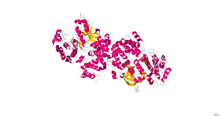G protein-coupled receptor kinase
| G protein-coupled receptor kinase | |||||||||
|---|---|---|---|---|---|---|---|---|---|
 | |||||||||
| Identifiers | |||||||||
| EC number | 2.7.11.16 | ||||||||
| Databases | |||||||||
| IntEnz | IntEnz view | ||||||||
| BRENDA | BRENDA entry | ||||||||
| ExPASy | NiceZyme view | ||||||||
| KEGG | KEGG entry | ||||||||
| MetaCyc | metabolic pathway | ||||||||
| PRIAM | profile | ||||||||
| PDB structures | RCSB PDB PDBe PDBsum | ||||||||
| Gene Ontology | AmiGO / EGO | ||||||||
| |||||||||
G protein-coupled receptor kinases (GRKs, GPCRKs) are a family of protein kinases that regulate the activity of G protein-coupled receptors (GPCRs) by phosphorylating their intracellular domains after their associated G proteins have been released and activated.
The phosphorylated serine and threonine residues act as binding sites for arrestin proteins that prevent the reassociation of the G proteins with their receptors, thereby preventing reactivation of the signaling pathway.
GRKs regulate also cellular responses independent of their kinase activity. In particular, G protein-coupled receptor kinase 2 interacts with a diverse repertoire of non-GPCR substrates.[2]
GRK1 is involved with Rhodopsin phosphorlylation and deactivation. Defects in GRK1 result in Oguchi disease 2.[3]
Types of GRKs
| Name | Notes | Gene | OMIM |
| G protein-coupled receptor kinase 1 | Rhodopsin kinase | GRK1 | 180381 |
| G protein-coupled receptor kinase 2 | β-Adrenergic receptor kinase 1 (BARK1) | GRK2 | 109635 |
| G protein-coupled receptor kinase 3 | β-Adrenergic receptor kinase 2 (BARK2) | GRK3 | 109636 |
| G protein-coupled receptor kinase 4 | Has been associated with regulation of kidney tubule function | GRK4 | 137026 |
| G protein-coupled receptor kinase 5 | Knockout mice have altered core body temperature | GRK5 | 600870 |
| G protein-coupled receptor kinase 6 | Knockout mice are supersensitive to dopaminergics[4] | GRK6 | 600869 |
| G protein-coupled receptor kinase 7 | Cone opsin kinase | GRK7 | 606987 |
See also
References
- ↑ PDB: 3C4W; Singh P, Wang B, Maeda T, Palczewski K, Tesmer JJ (May 2008). "Structures of rhodopsin kinase in different ligand states reveal key elements involved in G protein-coupled receptor kinase activation". J. Biol. Chem. 283 (20): 14053–62. doi:10.1074/jbc.M708974200. PMC 2376226
 . PMID 18339619.
. PMID 18339619. - ↑ Evron T, Daigle TL, Caron MG (March 2012). "GRK2: multiple roles beyond G protein-coupled receptor desensitization". Trends Pharmacol. Sci. 33 (3): 154–64. doi:10.1016/j.tips.2011.12.003. PMC 3294176
 . PMID 22277298..
. PMID 22277298.. - ↑ "GRK1 G protein-coupled receptor kinase 1 [ Homo sapiens ]". National Center for Biotechnology Information. Retrieved 14 April 2011.
- ↑ Gainetdinov RR, Bohn LM, Sotnikova TD, et al. (April 2003). "Dopaminergic supersensitivity in G protein-coupled receptor kinase 6-deficient mice". Neuron. 38 (2): 291–303. doi:10.1016/S0896-6273(03)00192-2. PMID 12718862. Retrieved 2009-08-14.
Further reading
- Sobierajska K, Fabczak H, Fabczak S (2005). "Mechanisms of Regulation and Function of G Protein-Coupled Receptor Kinases]". Postepy Biochemii (in Polish). 51 (4): 421–9. PMID 16676577.
- Ribas C, Penela P, Murga C, Salcedo A, García-Hoz C, Jurado-Pueyo M, Aymerich I, Mayor F (April 2007). "The G protein-coupled receptor kinase (GRK) interactome: role of GRKs in GPCR regulation and signaling". Biochimica et Biophysica Acta. 1768 (4): 913–22. doi:10.1016/j.bbamem.2006.09.019. PMID 17084806.
- Ma L, Gao J, Chen X (2005). "G Protein-Coupled Receptor Kinases". In Devi LA. The G Protein-Coupled Receptors Handbook (Contemporary Clinical Neuroscience). Totowa, NJ: Humana Press. ISBN 1-58829-365-3.
- Kurose H (2000). "G Protein-Coupled Kinases and Desensitization of Receptors". In Bernstein G, Tatsuya H. G protein-coupled receptors. Boca Raton: CRC Press. ISBN 0-8493-3384-9.